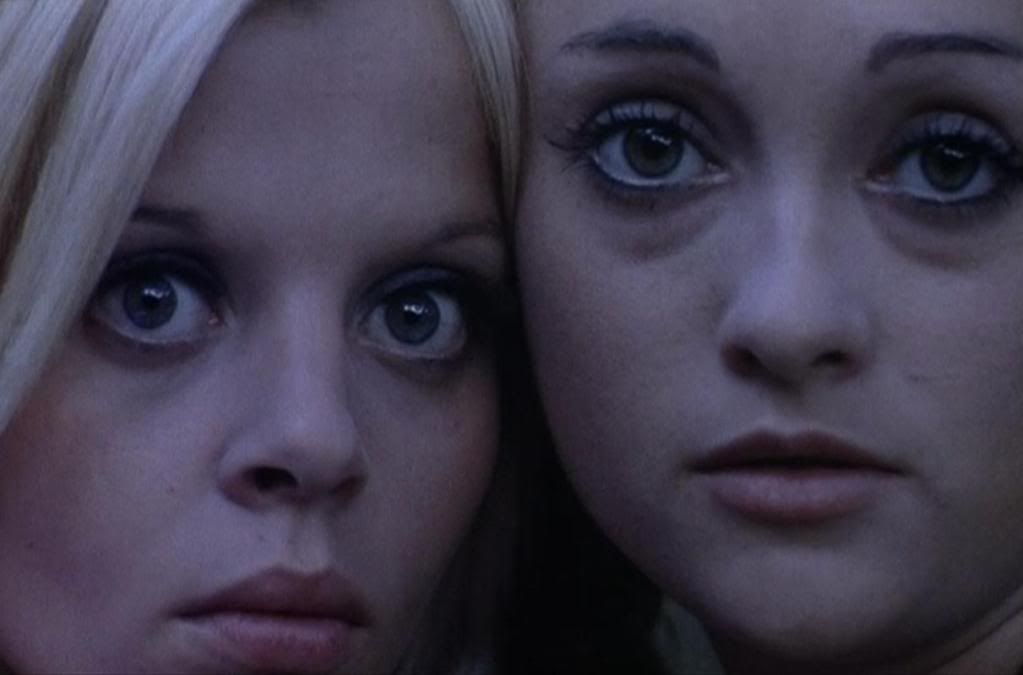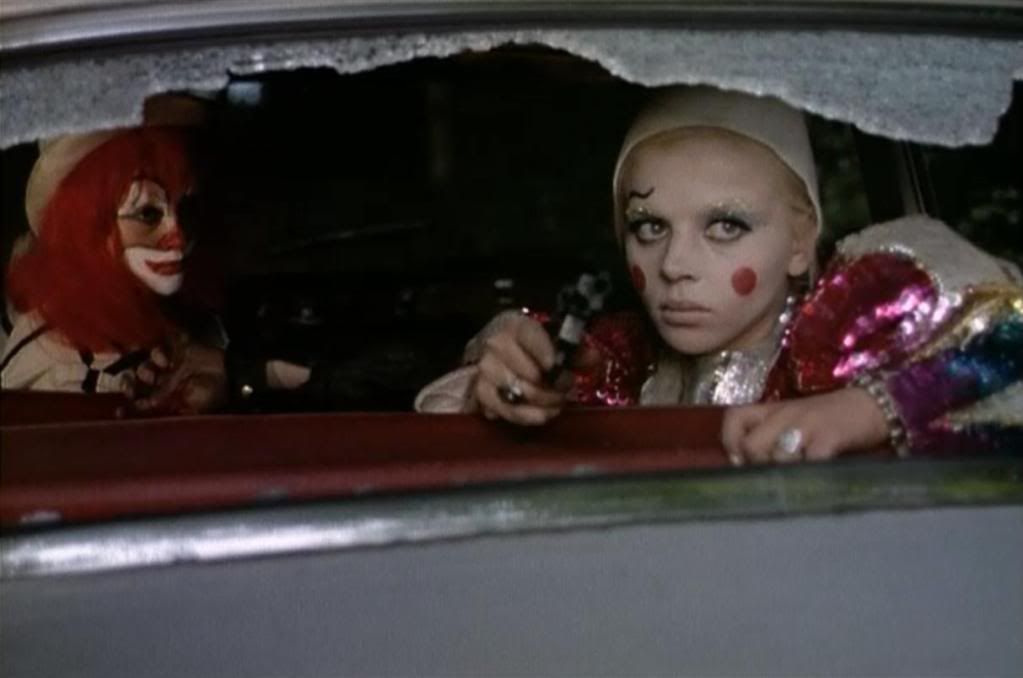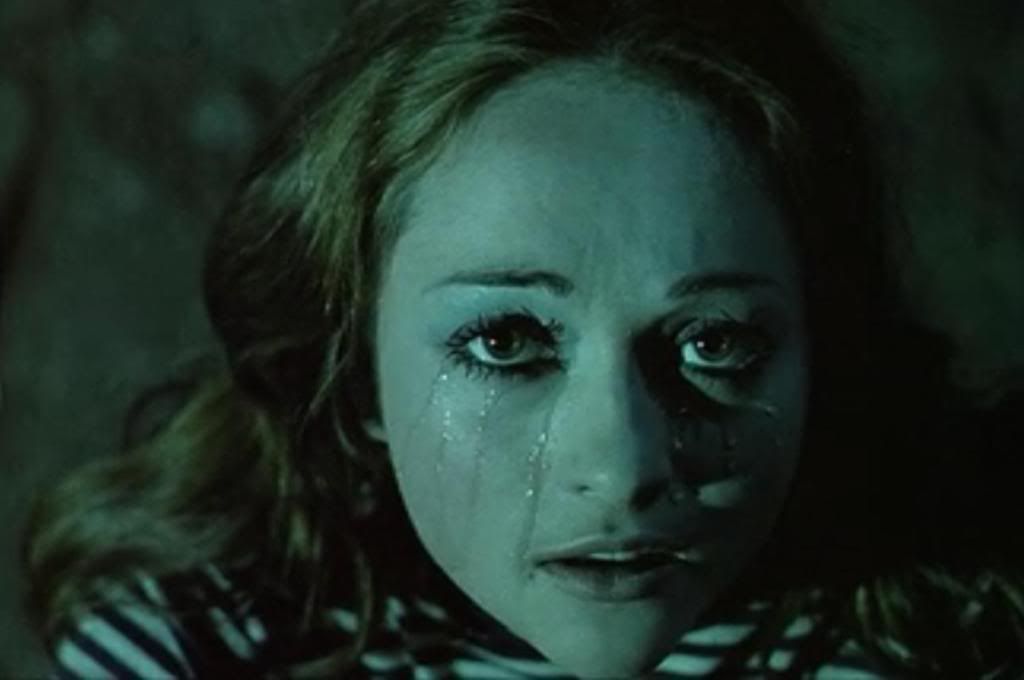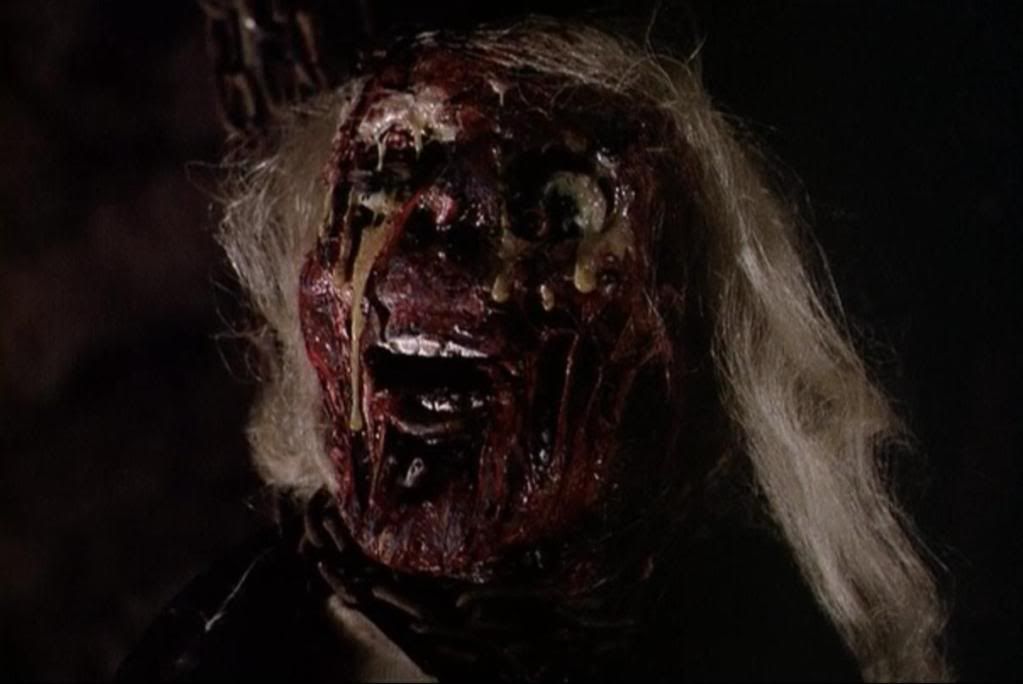

Jean Rollin's fourth film, Requiem for a Vampire, was the director's most abstract and bizarre vision yet. Rollin's surreal, alternately eerie and ridiculous vampire movies had always worked according to their own distinctive anti-logic, but here, more than ever, he'd seemingly reached a new level of confidence that allowed him to eliminate narrative altogether, focusing exclusively on the languid establishment of a mood through his vibrant imagery. There's hardly even any dialogue at all, and long stretches of time go by with not a word being spoken. The result is a pure expression of the director's obsessions, a dreamlike series of disconnected scenes in which the film's two beautiful heroines wander aimlessly into (and then out of) a gothic vampire tale.
Marie (Marie-Pierre Castel) and Michelle (Mireille Dargent) are introduced in a nonsensical opening sequence in which they're dressed as clowns, fleeing from mysterious pursuers, engaged in a gun battle in which their male companion is killed. They burn the car, shed their clown makeup and baggy clothes for tiny skirts, pigtails and knee-high socks, and head off through the barren countryside. This prologue is never explained, but it sets the tone of casual absurdity that will drive the film. The film moves at a relaxed pace, the camera slowly tracking around from a distance as the two girls wander through high grass, coming across an overgrown cemetery where they curl up together under a gravestone, and eventually arriving at a stone castle that's populated with vampires.


Rollin's heroines are inquisitive and bold, and they prowl through the castle like a pair of sapphic Nancy Drews, peeking around corners with their eyes wide, investigating these ruins, pausing only briefly to roll around naked together in bed. They come across a strange tableau in which skeletons in robes have been arranged around an altar, with a vampiress (Dominique Toussaint) sitting nearby, playing the organ and leering at the girls with comically large fangs sticking out over her lips. Even when the girls begin fleeing from the vampires and their savage, caveman-like servants, the pace remains narcotized and unsettlingly slow: a chase sequence plays out clumsily in a long shot in which the girls seem to be traipsing casually through a field of flowers while the vampires slowly advance in the distance. Rollin leaves large gaping ellipses that create a subtle sense of disorientation: after one caesura, the girls appear staring numbly ahead, vampire bats affixed to their necks, and then after another cut the bats are simply gone and the girls are left with twin red marks on their necks.
Rather than telling a story, Rollin seems to be working out his symbolism and fetishism of the vampire mythology at a purely primal, sensual level. The leader of the vampires keeps women chained in the basement of the castle, where they're raped and bitten by the vampires and their servants in an over-long and very gratuitous sequence, bathed in red colored lights as the women writhe around on their chains, culminating with a vampire turning into a bat to nestle in the pubic hair of one of the women. Rollin revels in this kind of outlandish imagery, celebrating the gothic sensuality of the vampire legend. During the arcane rituals at the film's climax, a vampire plays the piano in a graveyard while the two girls are led off one by one to be "initiated" by the male vampire, who can only transform virgins into his kind.


The film is a riff on sexuality and virginity, presenting a warped vision of the sexuality often associated with vampires. The two heroines, set to be inducted into vampirism, react in very different ways: while Michelle gives into her new vampiric thirsts, luring a man to the castle by stripping for him before she feeds on him, Marie finds a man as well but just has sex with him and then hides him away, telling the vampires that she couldn't find a victim. Rollin is reversing the usual hypocritical puritanism of so many horror movies, in which women who have sex are inevitably consumed by the movie's evil in the end. Here, it's the virgin who's corrupted, who gives into vampirism, while Marie, because she's no longer a virgin, retains her humanity and refuses to drink blood. Rollin isn't really interested in the love story, though, and at the film's climax, Marie's lover abruptly (and rather comically) gets sick of all this supernatural weirdness and runs off, leaving the two girls to escape together, reunited after the split caused by their different attitudes about vampires and sex.
That's a typical happy ending for Rollin, the girls wandering off into another adventure, leaving behind the rather melancholy and self-destructive vampires in their decrepit graveyard. Throughout the film, the girls flirt with the supernatural, with death and decay, and experiment with their sexualities, and then reaffirm their friendship and leave the darkness and the blood behind, presumably to return to their "ordinary" lives of dressing like clowns while engaging in shootouts and high-speed car chases.
Seems to me like I'll be enjoying this one a whole lot, thanks for the informative review, I will be getting this one asap.
ReplyDelete"a new level of confidence that allowed him to eliminate narrative altogether"
ReplyDeleteI actually got the opposite impression when I saw the film a few months ago; it felt to me like he loses his nerve about halfway through, as if he'd decided he'd better introduce something at least resembling a story. Great film, though, now I've got the new Kino Lorber edition I must watch it again...